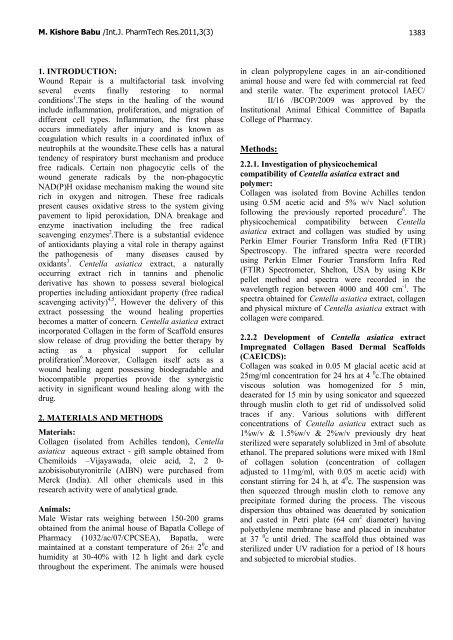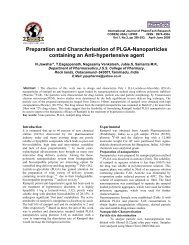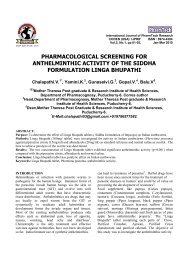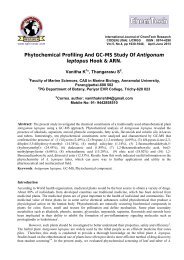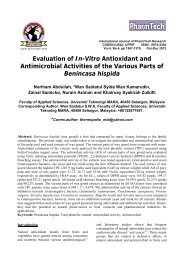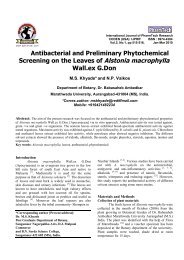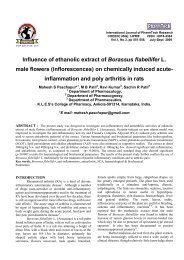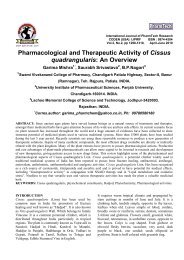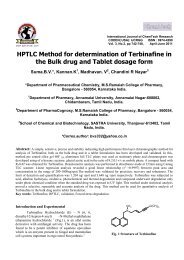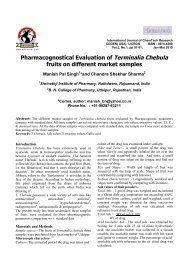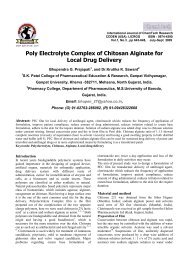Formulation & Evaluation of Centella asiatica extract impregnated ...
Formulation & Evaluation of Centella asiatica extract impregnated ...
Formulation & Evaluation of Centella asiatica extract impregnated ...
Create successful ePaper yourself
Turn your PDF publications into a flip-book with our unique Google optimized e-Paper software.
M. Kishore Babu /Int.J. PharmTech Res.2011,3(3) 1383<br />
1. INTRODUCTION:<br />
Wound Repair is a multifactorial task involving<br />
several events finally restoring to normal<br />
conditions 1 .The steps in the healing <strong>of</strong> the wound<br />
include inflammation, proliferation, and migration <strong>of</strong><br />
different cell types. Inflammation, the first phase<br />
occurs immediately after injury and is known as<br />
coagulation which results in a coordinated influx <strong>of</strong><br />
neutrophils at the woundsite.These cells has a natural<br />
tendency <strong>of</strong> respiratory burst mechanism and produce<br />
free radicals. Certain non phagocytic cells <strong>of</strong> the<br />
wound generate radicals by the non-phagocytic<br />
NAD(P)H oxidase mechanism making the wound site<br />
rich in oxygen and nitrogen. These free radicals<br />
present causes oxidative stress to the system giving<br />
pavement to lipid peroxidation, DNA breakage and<br />
enzyme inactivation including the free radical<br />
scavenging enzymes 2 .There is a substantial evidence<br />
<strong>of</strong> antioxidants playing a vital role in therapy against<br />
the pathogenesis <strong>of</strong> many diseases caused by<br />
oxidants 3 . <strong>Centella</strong> <strong>asiatica</strong> <strong>extract</strong>, a naturally<br />
occurring <strong>extract</strong> rich in tannins and phenolic<br />
derivative has shown to possess several biological<br />
properties including antioxidant property (free radical<br />
scavenging activity) 4,5 , However the delivery <strong>of</strong> this<br />
<strong>extract</strong> possessing the wound healing properties<br />
becomes a matter <strong>of</strong> concern. <strong>Centella</strong> <strong>asiatica</strong> <strong>extract</strong><br />
incorporated Collagen in the form <strong>of</strong> Scaffold ensures<br />
slow release <strong>of</strong> drug providing the better therapy by<br />
acting as a physical support for cellular<br />
proliferation 6 .Moreover, Collagen itself acts as a<br />
wound healing agent possessing biodegradable and<br />
biocompatible properties provide the synergistic<br />
activity in significant wound healing along with the<br />
drug.<br />
2. MATERIALS AND METHODS<br />
Materials:<br />
Collagen (isolated from Achilles tendon), <strong>Centella</strong><br />
<strong>asiatica</strong> aqueous <strong>extract</strong> - gift sample obtained from<br />
Chemiloids –Vijayawada, oleic acid, 2, 2 0azobisisobutyronitrile<br />
(AIBN) were purchased from<br />
Merck (India). All other chemicals used in this<br />
research activity were <strong>of</strong> analytical grade.<br />
Animals:<br />
Male Wistar rats weighing between 150-200 grams<br />
obtained from the animal house <strong>of</strong> Bapatla College <strong>of</strong><br />
Pharmacy (1032/ac/07/CPCSEA), Bapatla, were<br />
maintained at a constant temperature <strong>of</strong> 26± 2 0 c and<br />
humidity at 30-40% with 12 h light and dark cycle<br />
throughout the experiment. The animals were housed<br />
in clean polypropylene cages in an air-conditioned<br />
animal house and were fed with commercial rat feed<br />
and sterile water. The experiment protocol IAEC/<br />
II/16 /BCOP/2009 was approved by the<br />
Institutional Animal Ethical Committee <strong>of</strong> Bapatla<br />
College <strong>of</strong> Pharmacy.<br />
Methods:<br />
2.2.1. Investigation <strong>of</strong> physicochemical<br />
compatibility <strong>of</strong> <strong>Centella</strong> <strong>asiatica</strong> <strong>extract</strong> and<br />
polymer:<br />
Collagen was isolated from Bovine Achilles tendon<br />
using 0.5M acetic acid and 5% w/v Nacl solution<br />
following the previously reported procedure 6 . The<br />
physicochemical compatibility between <strong>Centella</strong><br />
<strong>asiatica</strong> <strong>extract</strong> and collagen was studied by using<br />
Perkin Elmer Fourier Transform Infra Red (FTIR)<br />
Spectroscopy. The infrared spectra were recorded<br />
using Perkin Elmer Fourier Transform Infra Red<br />
(FTIR) Spectrometer, Shelton, USA by using KBr<br />
pellet method and spectra were recorded in the<br />
wavelength region between 4000 and 400 cm -1 . The<br />
spectra obtained for <strong>Centella</strong> <strong>asiatica</strong> <strong>extract</strong>, collagen<br />
and physical mixture <strong>of</strong> <strong>Centella</strong> <strong>asiatica</strong> <strong>extract</strong> with<br />
collagen were compared.<br />
2.2.2 Development <strong>of</strong> <strong>Centella</strong> <strong>asiatica</strong> <strong>extract</strong><br />
Impregnated Collagen Based Dermal Scaffolds<br />
(CAEICDS):<br />
Collagen was soaked in 0.05 M glacial acetic acid at<br />
25mg/ml concentration for 24 hrs at 4 0 c.The obtained<br />
viscous solution was homogenized for 5 min,<br />
deaerated for 15 min by using sonicator and squeezed<br />
through muslin cloth to get rid <strong>of</strong> undissolved solid<br />
traces if any. Various solutions with different<br />
concentrations <strong>of</strong> <strong>Centella</strong> <strong>asiatica</strong> <strong>extract</strong> such as<br />
1%w/v & 1.5%w/v & 2%w/v previously dry heat<br />
sterilized were separately solublized in 3ml <strong>of</strong> absolute<br />
ethanol. The prepared solutions were mixed with 18ml<br />
<strong>of</strong> collagen solution (concentration <strong>of</strong> collagen<br />
adjusted to 11mg/ml, with 0.05 m acetic acid) with<br />
constant stirring for 24 h, at 4 0 c. The suspension was<br />
then squeezed through muslin cloth to remove any<br />
precipitate formed during the process. The viscous<br />
dispersion thus obtained was deaerated by sonication<br />
and casted in Petri plate (64 cm 2 diameter) having<br />
polyethylene membrane base and placed in incubator<br />
at 37 0 c until dried. The scaffold thus obtained was<br />
sterilized under UV radiation for a period <strong>of</strong> 18 hours<br />
and subjected to microbial studies.


